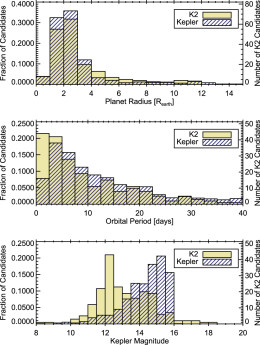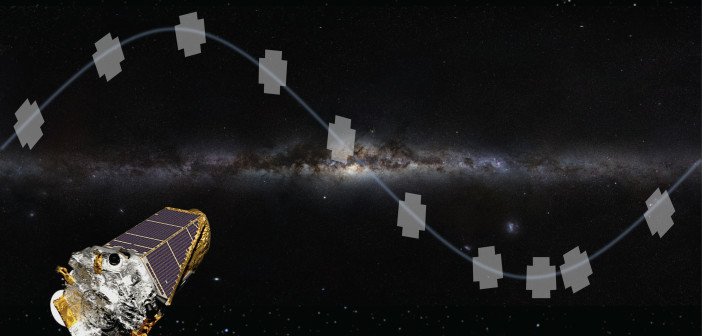Remember back in May 2013 when the second of Kepler’s reaction wheels failed, rendering it unable to control its precision pointing? As a result of a clever backup plan by intrepid scientists, Kepler is still going strong! This January, a paper was published describing some of the results from the first year of the extended Kepler mission, known as K2.
K2: A Second Chance

Histograms of the K2 planet candidate sample (solid yellow) compared with planet candidates from the first four months of Kepler observations (blue diagonal lines). The histograms compare planet radius, orbital period, and brightness. [Vanderburg et al. 2016]
Despite the significantly worsened pointing precision in the K2 mission, new analysis techniques have been developed that decouple the motion of the spacecraft from its observations, resulting in an observational precision for K2 that’s within 35% of the original precision achieved by Kepler.
Using these techniques, a team of scientists led by Andrew Vanderburg (Harvard–Smithsonian Center for Astrophysics) analyzed the publicly released data from the first year of the K2 mission. In a new study, they describe the results from the 59,174 targets that Kepler has observed in that time.
Planetary Candidates
Vanderburg and collaborators report that K2 has detected 234 planetary candidates around 208 stars in its first year. These candidates span a range of sizes from gas-giant to smaller than the Earth, and have orbital periods that range from hours to more than a month. The list includes:
- 26 candidates with sizes between 1 and 4 Earth radii, orbiting bright stars. These are well suited for precise radial velocity follow-up.
- 10 candidates with radii between 1.6 and 4 Earth radii that are likely to have gaseous envelopes. These are well suited for atmospheric characterization.
- 8 sub-Earth sized candidates, the smallest of which are about 0.75 times the size of Earth.
Vanderburg and collaborators make all of their data products (light curves, spectra, vetting diagnostics, etc.) publicly available. Their observations and data provide an excellent starting point for follow-up on the many potential planets discovered by K2 within the first year of its proposed three-year mission. And given this already long list of candidates, it’s clear that while Kepler’s power may have been reined in slightly, this telescope still has many more discoveries to show us.
Citation
Andrew Vanderburg et al 2016 ApJS 222 14. doi:10.3847/0067-0049/222/1/14
